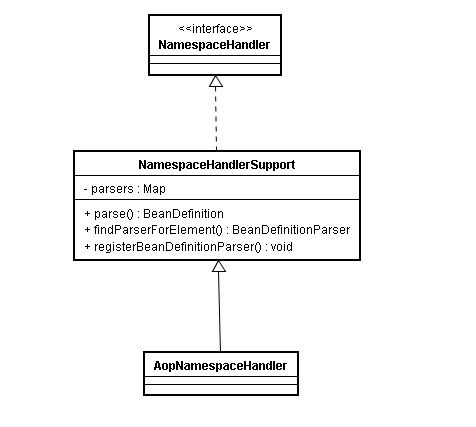之所以讲解DefaultNamespaceHandlerResolver类,是因为这个类跟解析xml的时候有着莫大的关联。并且从中也可以学到一些构建代码方法,先看一下我们的配置文件,一般我们会以这样的开头
<beans xmlns="http://www.springframework.org/schema/beans"
xmlns:xsi="http://www.w3.org/2001/XMLSchema-instance" xmlns:aop="http://www.springframework.org/schema/aop"
xmlns:tx="http://www.springframework.org/schema/tx" xmlns:context="http://www.springframework.org/schema/context"
xsi:schemaLocation="http://www.springframework.org/schema/beans http://www.springframework.org/schema/beans/spring-beans-3.0.xsd
http://www.springframework.org/schema/aop http://www.springframework.org/schema/aop/spring-aop-3.0.xsd
http://www.springframework.org/schema/tx http://www.springframework.org/schema/tx/spring-tx-3.0.xsd
http://www.springframework.org/schema/context http://www.springframework.org/schema/context/spring-context-3.0.xsd
http://www.springframework.org/schema/mvc
http://www.springframework.org/schema/mvc/spring-mvc-3.0.xsd">
。。。。。。。
其中的http://www.springframework.org/schema/beans,http://www.springframework.org/schema/aop,http://www.springframework.org/schema/context等这些是xml的命名空间。而spring解析xml的时候就是采用的方法和管理方法有点类似,就是分而治之,给你画一块地,这个就归你管理了,该怎么办就怎么办。spring解析xml的时候就是不同的xml名称空间用不同的类来解析,这样也是解耦了代码,同时更加容易扩展。下面就慢慢的揭开spring解析xml的面纱。。。。。。
如果 还没看前面一篇解析xml的文章,建议先看一下!spring解析xml到DefaultBeanDefinitionDocumentReader中的以下代码执行:
protected void parseBeanDefinitions(Element root, BeanDefinitionParserDelegate delegate) {
if (delegate.isDefaultNamespace(root)) {
NodeList nl = root.getChildNodes();
for (int i = 0; i < nl.getLength(); i++) {
Node node = nl.item(i);
if (node instanceof Element) {
Element ele = (Element) node;
//解析Beans标签等
if (delegate.isDefaultNamespace(ele)) {
parseDefaultElement(ele, delegate);
}
else {
//解析其他的命名空间
delegate.parseCustomElement(ele);
}
}
}
}
else {
delegate.parseCustomElement(root);
}
}
如果是其他的命名空间会到BeanDefinitionParserDelegate,这个类就是负责根据不同的xml名称空间分发解析xml了,就像公司的Boss,他负责给每个部门的老大任务。根据什么样的方式来分配任务呢?且看下面:
public BeanDefinition parseCustomElement(Element ele, BeanDefinition containingBd) {
String namespaceUri = getNamespaceURI(ele);
//这里的getNamespaceHandlerResolver就像是秘书,根据不同的任务找到不同部门
//这里的readerContext就是Boss了
NamespaceHandler handler = this.readerContext.getNamespaceHandlerResolver().resolve(namespaceUri);
if (handler == null) {
error("Unable to locate Spring NamespaceHandler for XML schema namespace [" + namespaceUri + "]", ele);
return null;
}
//这里的readerContext就是解析上下文,用于不同类解析完成后像容器注册BeanDefinition
return handler.parse(ele, new ParserContext(this.readerContext, this, containingBd));
}
公司的Boss想了一下,你们每个部门不的都有名称么,每个部门自己的职能Boss自己不知道就找秘书,根据这些来分配任务了。spring也是一样,你xml标签不是都有自己的名称空间么,好我就以名称空间给你一亩地。你就负责好管理你这块地了。但是Boss怎么知道下面的每个部门完成任务了呢?是不是要实时的监控下,给每个部门老大办公室安装一个视频监控器。Boss就每天坐家里看你们有没有完成。要是这样那估计部门老大干完一天就走人了,大爷我不干了。你这监视我,就是不信任我啊,再说我还哪有自由可言,还没隐私了。不干了。呵呵,Boss想了一下不能这么干。high不了啊。好,那我就给你一个接口,你干好了,你就自动提交任务吧。这里的readerContext就是这样的接口了。这次我也完全信用你了,都不给你时间限制。你就慢慢玩吧。这样的Boss,估计每个部门老大都很high了。
但是Boss在什么地方去根据什么样的任务分配给部门呢?Boss肯定都有一个秘书,找秘书吧。(怎么创建Boss和秘书的就要看解析xml了)嗯,秘书就乖乖给Boss一个本子,记录着呢,都在DefaultNamespaceHandlerResolver这个记事薄上,在下面的一页:
public NamespaceHandler resolve(String namespaceUri) {
//秘书从资料夹上得到资料
Map<String, Object> handlerMappings = getHandlerMappings();
Object handlerOrClassName = handlerMappings.get(namespaceUri);
if (handlerOrClassName == null) {
return null;
}
else if (handlerOrClassName instanceof NamespaceHandler) {
return (NamespaceHandler) handlerOrClassName;
}
else {
String className = (String) handlerOrClassName;
try {
Class<?> handlerClass = ClassUtils.forName(className, this.classLoader);
if (!NamespaceHandler.class.isAssignableFrom(handlerClass)) {
throw new FatalBeanException("Class [" + className + "] for namespace [" + namespaceUri +
"] does not implement the [" + NamespaceHandler.class.getName() + "] interface");
}
//创建一个部门
NamespaceHandler namespaceHandler = (NamespaceHandler) BeanUtils.instantiateClass(handlerClass);
//这个是部门创建后招员工的方法,会在下面讲解
namespaceHandler.init();
handlerMappings.put(namespaceUri, namespaceHandler);
return namespaceHandler;
}
catch (ClassNotFoundException ex) {
throw new FatalBeanException("NamespaceHandler class [" + className + "] for namespace [" +
namespaceUri + "] not found", ex);
}
catch (LinkageError err) {
throw new FatalBeanException("Invalid NamespaceHandler class [" + className + "] for namespace [" +
namespaceUri + "]: problem with handler class file or dependent class", err);
}
}
}
/**
* Load the specified NamespaceHandler mappings lazily.
*/
private Map<String, Object> getHandlerMappings() {
//不幸,秘书第一次找到是空的,那就初始化吧
if (this.handlerMappings == null) {
synchronized (this) {
if (this.handlerMappings == null) {
try {
//秘书通过工具PropertiesLoaderUtils查找资料吧,不能手工啊,多麻烦
//这里的资料都记在叫META-INF/spring.handlers这个名字的架上,并且这样的架还挺多的
Properties mappings =
PropertiesLoaderUtils.loadAllProperties(this.handlerMappingsLocation, this.classLoader);
if (logger.isDebugEnabled()) {
logger.debug("Loaded NamespaceHandler mappings: " + mappings);
}
Map<String, Object> handlerMappings = new ConcurrentHashMap<String, Object>(mappings.size());
CollectionUtils.mergePropertiesIntoMap(mappings, handlerMappings);
this.handlerMappings = handlerMappings;
}
catch (IOException ex) {
throw new IllegalStateException(
"Unable to load NamespaceHandler mappings from location [" + this.handlerMappingsLocation + "]", ex);
}
}
}
}
return this.handlerMappings;
}
秘书就从资料架上找啊找,发现都记录在META-INF/spring.handlers这个名字的架上,然后通过PropertiesLoaderUtils工具全部找出来,记录在资料本某一页上。其中工具就是这样执行的。
public static Properties loadAllProperties(String resourceName, ClassLoader classLoader) throws IOException {
Assert.notNull(resourceName, "Resource name must not be null");
ClassLoader clToUse = classLoader;
if (clToUse == null) {
clToUse = ClassUtils.getDefaultClassLoader();
}
Properties props = new Properties();
Enumeration urls = clToUse.getResources(resourceName);
while (urls.hasMoreElements()) {
URL url = (URL) urls.nextElement();
URLConnection con = url.openConnection();
ResourceUtils.useCachesIfNecessary(con);
InputStream is = con.getInputStream();
try {
if (resourceName != null && resourceName.endsWith(XML_FILE_EXTENSION)) {
props.loadFromXML(is);
}
else {
props.load(is);
}
}
finally {
is.close();
}
}
return props;
}
把所有classpath路径下META-INF/spring.handlers都找到并返回。这样秘书就可以回馈给Boss了。也可以交任务了。所以你到spring下的lib下看,会发现bean,aop,context,tx,jdbc等都会有 META-INF/spring.handlers文件。Boss根据秘书把任务分配好了,这里就要看部门老大怎么完成任务呢。这里讲一个实例,看其中的一个aop名称空间的解析,先看其jar文件下的META-INF/spring.handlers文件内容。发现啊aop的部门老大呢为AopNamespaceHandler类。
